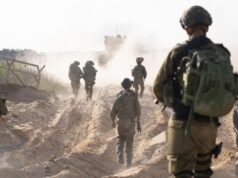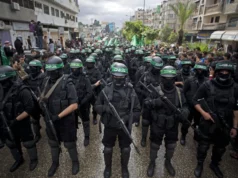The so-called “Arab Spring” was a response to the inability of dictatorial Middle East governments to provide jobs and economic success to a rising, educated generation of young people. I used to have a lecture entitled Corruption, Money, Sex & Humiliation: The Arab Spring in Four Words. It was very popular.
The American response should have been a combination of economic assistance for entrepreneurs, including the easing of governmental red tape (remember that the first protester in Tunisia was a man who committed suicide because he couldn’t get a government permit for his vegetable cart), and advocating for government transparency and Rule of Law. But because the U.S. likes “elections” and “democratic form” if not democratic function, in each case, Islamists were able to capitalize on the corruption of their secular predecessors and “win” an election that was actually a referendum. Hamas did that even before the Arab Spring; Turkey’s AKP did it even before Hamas. Tunisia, Libya and Egypt had varying results.
There is nothing democratic about their governance even if they did win a majority or a plurality in a referendum. And their victories spurred secular despots such as Bashar Assad, and modern monarchs like King Abdullah II of Jordan to become more repressive toward their own opposition, Muslim Brotherhood or not.
Mixing the Revolutions
March 2012 was a crucial time in the Syrian rebellion. The uprising to that point had been peaceful, forcing Assad to fight on his least favorite field – the moral high ground. The rebellion decided to militarize by March and quickly took to the field. That should have been a tip-off that military organizations were already involved. Revolts don’t just spring up fully armed; accountants and teachers don’t suddenly become fighters. The same was true in Libya, where suddenly there were armed militias going to war. There was outside organization involved in both rebellions – al Qaeda in Libya and the Muslim Brotherhood in Syria.
In 1983, Assad’s father had killed 30,000 or more people in Hama in an attempt to crush the Brotherhood. He forced it underground, much like the Egyptians had done in the 1950s, but it didn’t disappear. The public rise of the Brotherhood in Egypt after the 2011 ouster of Hosni Mubarak spurred the Syrian Brotherhood. After the June 2012 Brotherhood victory in Egypt, Bashar Assad knew he would be facing revenge for Hama. He was spurred to much greater levels of destructiveness, understanding as neither the Russians nor we did that both sides were now in it to the death – of 100,000 Syrians thus far.
It was never the case that Western “arming the Syrian rebels” would have produced a pro-Western, democratic or secular rebellion. The Brotherhood had been waiting underground in Syria to re-emerge just as it was waiting in Egypt to re-emerge, to take revenge.
There might have been an early deal between the U.S. and the Russians – Assad and the Iranians out; a secular government under Russian patronage would stay – but the U.S. couldn’t see the bigger picture. We scolded and denounced the Russians at the UN right from the beginning, helping to lock them into their chosen position, and reducing their maneuvering room.
The Russians have chosen the Shiite side in Syria because Putin’s greatest fear is a revival of the Sunni Islamist insurgency in Chechnya and Dagestan. More than 160,000 people were killed in Chechnya – that the Russians acknowledge – and the roots of the insurgency are still there. Saudi support for the rebellion shifted it from a traditional nationalist war into an Islamic war against the infidel Orthodox Christian Russians. For the Russians, it is better to have an Iranian bomb than Chechens with Stinger missiles.
Its not just Sunni-Shiite
But “the war” is not only Sunni vs. Shiite. Yes, the Iranians and Hezbollah support the heterodox Shiite Assad, and the Sunni Saudis and Qataris and Turks support the rebellion, but…
There is also a split among the Sunnis, with Qatar and Turkey supporting the Muslim Brotherhood, and the Saudis supporting more extreme Salafists. Both have been known to work with al Qaeda when necessary – although al Qaeda is virulently anti-Saudi. Qatar and Saudi Arabia are in the middle of a huge rift exacerbated by Qatar’s support for the Morsi government and Saudi Arabia’s congratulatory message to the military and promise of aid after the coup.
The Revolution in Egypt
The London Sunday Times points to what had been the increasing closeness of the Morsi government to the Shiite government in Iran – an oddity, but he was looking for money. Ahmadinejad visited Cairo in February, and later told reporters that Iran would “defend Egypt” if necessary. The Egyptian military took that as an insult and complained to Morsi. According to the Egyptian papers, General Sisi believed there was a government plot to Islamize the military and oust him – so he struck first.
The U.S. appears stuck primarily because we seem to believe the money we give the Egyptian military is simply to keep the peace with Israel. That is not true. The Egyptian military has NO desire to go to war with Israel, very much values its relationship with the U.S., including joint operations and access by Egyptians to American military schools and training. The Egyptian military is fully aware that its enemy is Islamic Jihad – operating in Sinai, and supported by the Muslim Brotherhood and Iran, together and separately.
That gives us leverage if we’re prepared to use it. We should suspend the aid right now – our next delivery is supposed to be 4 F-16 aircraft, which are unresponsive to the actual threats facing Egypt – until we have assurances from the military that a) it will not be running the country (which they’ve actually already given us and appear to be serious about) and b) parties that want to run in next year’s election meet minimal standards of transparency and commitments to individual civil liberties and rule of law. In order to get to that point, the U.S. should also insist that the military overturn the convictions of the American and Egyptian NGO workers.
In exchange, we should not only restore military aid, but also offer assistance with other international financing bodies. Egypt’s biggest problems are it’s agricultural sector – which requires major overhaul, the heavy subsidies on food and fuel, and red tape for business. All of which the U.S. can help address.
The main problems are now what they were during the Mubarak era. In effect, the U.S. has been given a diplomatic “do over” to insist that the revolution be conducted on economic and transparency grounds. If the current Egyptian constellation succeeds, we should be promising them more assistance in international lending institutions and more targeted assistance to small business and agriculture.
The “Takeaways” Are:
1. When you think you know who’s “winning,” you’re probably wrong. The Muslim Brotherhood looked invincible a few months ago – Egypt, Syria, Turkey, Jordan and Hamas. Other forms of “political Islam” were ascending as well. The Egyptian demonstration on June 30 was, according to people who study those things, the largest human gathering in history. Between 19 and 30 million people congregated to demand a “mulligan” on the revolution and on the election of the Muslim Brotherhood.
a. Egypt is unlikely to have a Muslim Brotherhood government again
b. Turkey’s demonstrations have been against power grabs by the Muslim Brotherhood-associated government
–> In both places, the number of religious people demonstrating against religious government is astounding – and a very hopeful sign.
c. The governments of Saudi Arabia, Kuwait, Jordan and the UAE favored the military over the Brotherhood; so did Syria.
2. According to Middle East scholar Daniel Pipes, when religious groups appear to be rising, they begin to fight each other.
a. Shiite Iran had made common cause with Sunni Hamas, but Hamas broke with Iran and Hezbollah over Syria and Iran has cut off its money and weapons.
–> The Egyptian military is anti-Hamas
b. The border between Lebanon and Syria is being erased; look for increased violence in Lebanon
c. Watch for a growing rift between Turkey and Egypt
–> The leadership in Cairo today accused Turkey of interfering with Egypt’s internal politics.
d. We tend to think of “the Gulf States” as a unit – they’re not.
–>. The Syrian revolt and the Egyptian coup exposed the rift between Qatar and Saudi Arabia, two of the most important states in the region.
—-> 28 al Jazeera employees in Egypt resigned Monday because they said the government of Qatar (which owns al Jazeera) was slanting the news.
3. A takeaway for the United States is to be much more hesitant about arming the rebels in Syria. It is not clear what will happen there, but it is probably a good thing for the U.S. NOT to be empowering Sunni Islamist jihadists. It is also a good thing that it isn’t happening with American troops involved in another Middle Eastern war. Humanitarian assistance and support for our ally Jordan should be the U.S. priorities.
And finally:
4. Despite the violence around its borders, Israel is actually not in a bad position.
a. The Arab countries used to come together to denounce Israel – now they denounce each other.
–> A Kuwaiti legislator announced in Parliament that he’s pleased to say Israel supplies equipment to Kuwait to help the Sheikdom defend itself. “If Kuwaiti security requires the purchase of Israeli equipment, I will do so & love the Israelis for it.”
b. All of that violence used to be well-managed armies poised to hit Israel – now they are used in varying forms against each other and against their own people. As long as Israel maintains red lines that the neighbors understand as lines, Israel will manage, as it always has to defend its people in a difficult neighborhood.





